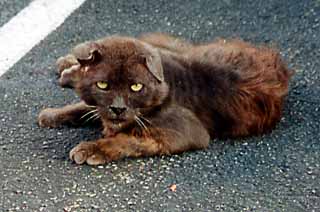Naked City
Here, Kitty, Kitty, Kitty, Kitty, Kitty…
By Jordan Smith, Fri., June 29, 2001

Austin's population boom -- and more recently, bust -- has plenty of unpleasant side effects: the influx of Californians, for example. But one consequence you may not have been aware of is the dramatic increase in the number of feral cats prowling around Austin's streets -- dumped, lost, or abandoned felines that have become essentially wild after years without human contact. According to feral cat advocates, there are around 135,000 such kitties in Austin; they live wherever they can find a reliable food source. "Feral cats are probably living behind every Dumpster in Austin," said Rae Maxwell, an Animal Trustees of Austin volunteer who has been helping trap and treat feral cats in the Capital City for the past 10 years. "It's a huge problem -- [a result of] population growth and just that people are idiots. People move and consider their animals expendable."
The problem isn't confined to Austin. Animal activists estimate there are between 60 and 100 million feral cats nationwide. But if Maxwell and other local advocates have their way, Austin's feral cat population could soon be on the decline with the aid of a cat "management" program called Trap-Neuter-Release, or TNR. "Our solution is to trap them, spay or neuter, and vaccinate them," said Kathy Pardue, an ATA volunteer and creator of the new Web site austinferalcats.org. "Then at least they will stop breeding. Sterilization is a widely used form of population control for wildlife management, and feral cats are no exception."
In fact, the biggest contributor to the increase in Austin's feral cat population -- besides "dumping," which advocates say increases any time the economy is in a downturn -- is breeding. Cats, unlike dogs, stay in heat until they breed, and are able to breed almost continuously. "After a couple of seasons of breeding, the effects on the population are astronomical," said Zoe Carson, a spokeswoman for Alley Cat Allies, a national feral cat advocacy group. "They're almost as bad as rabbits."
Under a TNR system, volunteers trap the cats, take them to a veterinarian to be spayed or neutered, have them vaccinated, and then release them back to their "colony." Once the cats are back on the street, volunteers also act as "colony managers," feeding and keeping watch over the colony. The programs, advocates say, are extremely successful. One colony that Maxwell has managed for the past 10 years has shrunk from 200 to 20 cats, where it has remained for the past couple of years. And at the University of Texas, where administrative assistant Jan Shrode has been running the Campus Cat Coalition TNR program since 1995, the campus population has been reduced to 50 cats. "And we haven't had any kittens in three years," Shrode said.
In addition to sterilizing the adults, volunteers have been successful at trapping, "socializing," and finding homes for the kittens. "We've gotten at least 70 kittens out of here, socialized them, and put them up for adoption," Shrode said.
TNR programs are also less expensive than the alternatives: calling animal control, "warehousing" the animals in control facilities, and then euthanizing them. TNR "costs about $30, where responding to complaint calls, housing, and euthanizing costs about $100," said Carson of Alley Cat Allies. "And with TNR the population is immediately reduced, sometimes substantially." Not to mention that calling animal control, housing ,and euthanization are paid for by city taxpayers, while the TNR programs are paid for with donations made to ATA or the Austin Society for the Prevention of Cruelty to Animals. Of course, that can be a mixed blessing: The Austin SPCA has had to temporarily suspend its feral cat programs because of a lack of funding. (The SPCA will hold its fourth-annual telethon this weekend on K-EYE, ch. 42.)
Austin advocates said they would love to see TNR become the standard for dealing with feral cats here. "But it's going to take more education," said Maxwell. "We have to educate people on how they can help take responsibility, not necessarily for their own actions, but for the irresponsibility of others." Meanwhile, Maxwell said she will continue to pursue Austin's feral felines. "It's a great adrenaline rush. If you don't drink or anything, go feraling."
For more info on how to deal with feral cats or about volunteering with a TNR program, look online at www.austinferalcats.org, or at the Campus Cat Coalition Web site: www.ae.utexas.edu/cats. Or call the Animal Trustees of Austin at 320-0388 or the Austin SPCA at 837-7985.
Got something to say on the subject? Send a letter to the editor.








